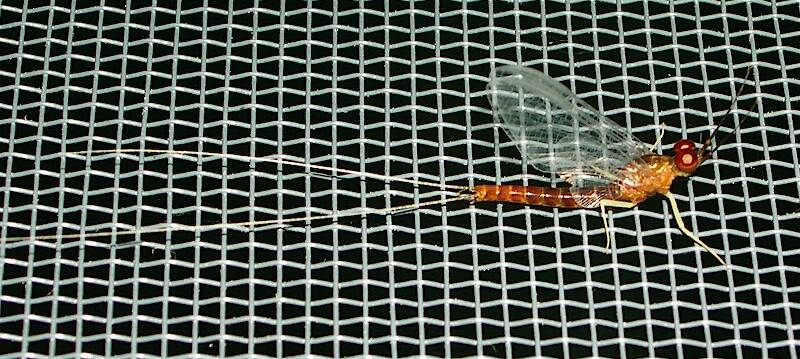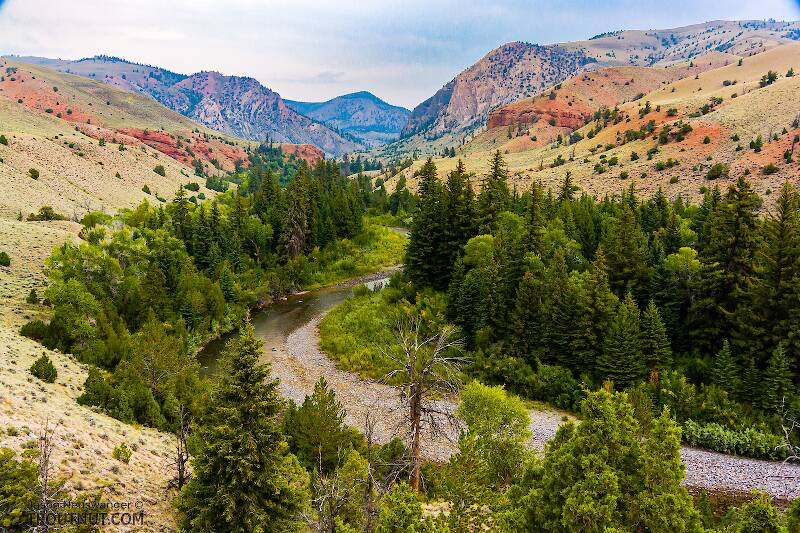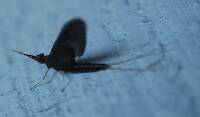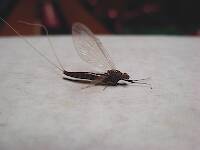
Blue-winged Olives
Baetis
Tiny Baetis mayflies are perhaps the most commonly encountered and imitated by anglers on all American trout streams due to their great abundance, widespread distribution, and trout-friendly emergence habits.
Featured on the forum

This is a striking caddis larva with an interesting color pattern on the head. Here are some characteristics I was able to see under the microscope, but could not easily expose for a picture:
- The prosternal horn is present.
- The mandible is clearly toothed, not formed into a uniform scraper blade.
- The seems to be only 2 major setae on the ventral edge of the hind femur.
- Chloride epithelia seem to be absent from the dorsal side of any abdominal segments.
Based on these characteristics and the ones more easily visible from the pictures, this seems to be Grammotaulius. The key's description of the case is spot-on: "Case cylindrical, made of longitudinally arranged sedge or similar leaves," as is the description of the markings on the head, "Dorsum of head light brownish yellow with numerous discrete, small, dark spots." The spot pattern on the head is a very good match to figure 19.312 of Merritt R.W., Cummins, K.W., and Berg, M.B. (2019). The species ID is based on Grammotaulius betteni being the only species of this genus known in Washington state.
- The prosternal horn is present.
- The mandible is clearly toothed, not formed into a uniform scraper blade.
- The seems to be only 2 major setae on the ventral edge of the hind femur.
- Chloride epithelia seem to be absent from the dorsal side of any abdominal segments.
Based on these characteristics and the ones more easily visible from the pictures, this seems to be Grammotaulius. The key's description of the case is spot-on: "Case cylindrical, made of longitudinally arranged sedge or similar leaves," as is the description of the markings on the head, "Dorsum of head light brownish yellow with numerous discrete, small, dark spots." The spot pattern on the head is a very good match to figure 19.312 of Merritt R.W., Cummins, K.W., and Berg, M.B. (2019). The species ID is based on Grammotaulius betteni being the only species of this genus known in Washington state.

Troutnut is a project started in 2003 by salmonid ecologist Jason "Troutnut" Neuswanger to help anglers and
fly tyers unabashedly embrace the entomological side of the sport. Learn more about Troutnut or
support the project for an enhanced experience here.

Wystone
Posts: 1
Posts: 1
Wystone on Aug 12, 2007August 12th, 2007, 3:57 am EDT
Identication help? Center Maine region ( NW of Bangor). Picture taken early July.
Screen openings 2mm
Screen openings 2mm
Martinlf on Aug 12, 2007August 12th, 2007, 4:11 am EDT
I'll leave the ID to the professionals, but great photo and measurement idea.
"He spread them a yard and a half. 'And every one that got away is this big.'"
--Fred Chappell
--Fred Chappell
Taxon on Aug 12, 2007August 12th, 2007, 8:06 am EDT
Male spinner. Isonychia ?
Yes, it would appear to be. There are (at least) three Isonychia species recorded from Maine, I. bicolor, I. georgiae, and I. obscura. Although the greatest statistical likelihood would be I. bicolor, reliable identification to species requires microscopic examination of male imago genitalia.
Luckily, we have a mayfly entomologist actively participating on this forum, who is qualified to make such an identification, if sent a preserved specimen. See this thread.
JAD on Aug 12, 2007August 12th, 2007, 1:49 pm EDT
If I could taste it, I could tell you :) nice picture.
JaD
They fasten red (crimson red) wool around a hook, and fix onto the wool two feathers which grow under a cock’s wattles, and which in colour are like wax.
Radcliffe's Fishing from the Earliest Times,
Quick Reply
Related Discussions
Topic
Replies
Last Reply
0
Jul 3, 2006
by Troutnut
by Troutnut
13
Jul 25, 2014
by Millcreek
by Millcreek
8
Jun 5, 2007
by Dinerobyn
by Dinerobyn






